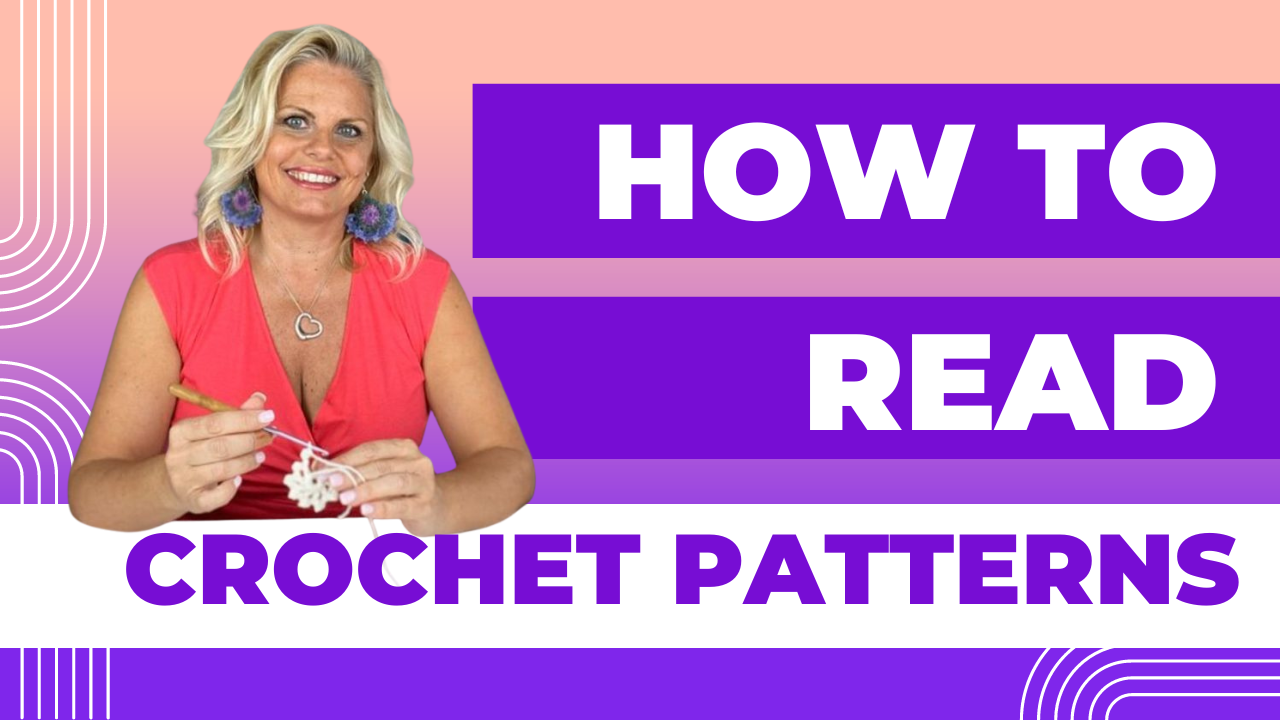“I love your patterns! I can crochet but I can’t follow a crochet pattern.”
I understand, I get it. You know how to crochet but you can’t read a pattern. It looks like a foreign language. This is a comprehensive guide to the most commonly asked questions about how to read crochet patterns. Crochet patterns are a wonderful resource for your crochet journey but until you know how to read them, they can look like they are written in a foreign language!
How can I find out what the abbreviations mean in crochet patterns?
Sometimes a book or pattern will have a list of abbreviations included inside. It is also readily available information you can find on many different websites. The most comprehensive list of US terminology can be found at Craft Yarn Council of America.
British crochet terminology and American crochet terminology differ. Make sure you know whether the pattern is written in British or American style to know which set of terminology to follow.
I also have an extensive list of crochet terminology and definitions of stitches and video tutorials here How to Crochet
What does an asterisk mean in crochet patterns?
When a crochet pattern has instructions that are repeated multiple times in a row, it is easier to read the instructions when they are condensed into repeats. An asterisk will be placed at the beginning of the repeated instructions. Afterwards there will be instructions to repeat from * with indication of how many times. It could say repeat from * three times, twenty times, or simply say repeat from * across or around if you repeat it for the entire row/round.
For examples:
Row 1: Dc in 5th ch from hook, *ch1, skip 1 ch, dc in next ch. Rep from * across.
Row 1: Ch3 (counts as dc), 1dc in ea of next 2 sts, *ch3, skip next st, 2dc-cl in next st. Rep from * fourteen times, ch3, skip 1 st, 1dc in ea of next 3 sts.
What do brackets and parenthesis mean in crochet patterns?
Brackets and/or parenthesis are symbols that indicate when a section of the pattern is repeated a certain number of times. While an asterisk can indicate that a pattern is repeated the entire row/round, brackets and parenthesis usually indicate when a section within the row is repeated a certain number of times. And when combined together in the same row, the brackets are the larger repeat and the parenthesis indicate a repeat within the bracket repeat.
For examples:
Row 5: Ch3 (counts as dc), 1dc in ea of next 2 sts, *(ch3, skip 2 dcs, dc in next dc)x3, ch3, skip 2 dcs, 5dc in next dc. Rep from * across to last 5 sts: ch3, skip 2 dcs, 1dc in ea of last 3 dcs.
In this example, you repeat the instructions in the parenthesis three times before moving on further in the row.
Row 9: Ch3 (counts as dc), *[ch3, skip 2dc, 2dc-cl in next dc, (ch1, skip 1 dc, 1dc in next dc)x3]x5. ch3, skip 2dcs, 1dc in last dc.
In this example, you repeat the instructions in brackets 5 times and within each of those repeats, you repeat the instructions inside the parenthesis 3 times.
When used alone, either brackets or parenthesis can be used interchangeably. How a designer chooses to format their writing style can differ from one designer to another.
How to Read Line by Line Instructions in a crochet pattern:
Line by line instructions are the words that spell out every stitch and all the guidelines of a pattern. Oftentimes, a chart can express the same instructions in a more concise way, but not all instructions are (or can be) written in chart form.
For example, let’s say we have the following pattern in a single row. This is how the actual stitches would be worked for a row with one repeat:
Ch3 (counts as dc), dc in same st, dc in next st, dc in next st, dc in next st, dc in next st, skip 2 sts, dc in next st, dc in next st, dc in next st, dc in next st, dc in ch2 sp, ch2, dc in same ch2 sp, dc in next st, dc in next st, dc in next st, dc in next st, skip 2 sts, dc in next st, dc in next st, dc in next st, dc in next st, dc in ch2 sp, ch2, dc in same ch2 sp, dc in next st, dc in next st, dc in next st, dc in next st, skip 2sts, dc in next st, dc in next st, dc in next st, dc in next st, 2dc in last st.
Now let’s look at the same instructions with summarization and parentheses used to mark the small sections of stitches within the pattern repeat:
Ch3 (counts as dc), dc in same st, 1 dc in ea of next 4 sts, skip 2 sts, 1 dc in ea of next 4 sts, (dc, ch2, dc) in next ch2 sp, 1 dc in ea of next 4 sts, skip 2 sts, 1 dc in ea of next 4 sts, (dc, ch2, dc) in next ch2 sp, 1 dc in ea of next 4 sts, skip 2sts, 1 dc in ea of next 4 sts 2dc in last st.
Finally, here is the same line written if the center stitches are a multiple for a larger row:
Ch3 (counts as dc), dc in same st, *1dc in ea of next 4 sts, skip 2 sts, 1dc in ea of next 4 sts, (dc, ch2, dc) in next ch2 sp. Rep from * across, but on last repeat, omit working into ch2 sp and work 2dc in last st.
How to Read Charts:
Charts are an even more concise way to view stitch instructions. They are a great tool because they are universal and can be read regardless of the language you speak. Additionally, the more you use charts, the more you can ‘see’ what
the pattern will look like before you actually begin crocheting! And because the anatomy of the stitches is well represented in chart form, if you set 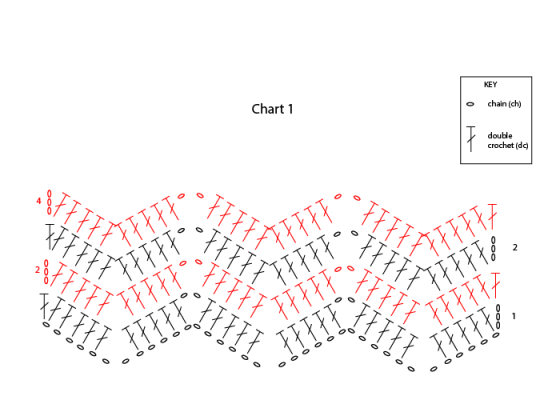 your work down next to its chart, you can often recognize your mistakes, too. Chart 1 is an example of the same instructions on the previous page, but concisely drawn in chart form.
your work down next to its chart, you can often recognize your mistakes, too. Chart 1 is an example of the same instructions on the previous page, but concisely drawn in chart form.
Row Charts:
If the chart is written for rows of stitches, it should be read in the same direction as the crochet in your hands: from the bottom up, from right to left (the perspective of the right side facing). On wrong side rows, you read the chart from left to right because you have turned your work.
Note: This is based on right-hand crocheting.
Motif Charts:
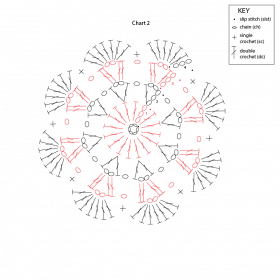 If the chart is written for a project that is circular, or worked in the round, all the rounds on the chart are read from the center out, in a counter-clockwise direction. Usually rounds are drawn in alternating colors to make it easier to see where one ends and the next begins. See chart 2 as an example.
If the chart is written for a project that is circular, or worked in the round, all the rounds on the chart are read from the center out, in a counter-clockwise direction. Usually rounds are drawn in alternating colors to make it easier to see where one ends and the next begins. See chart 2 as an example.
All charts are written using the same universal language of stitch symbols. A key is often given to label each symbol with its respective stitch.
What does gauge mean in a crochet pattern?
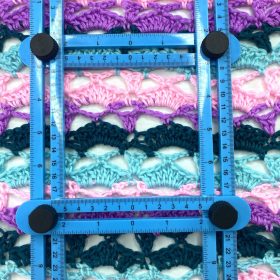 Gauge is a measurement of how many stitches and rows are included within one inch of fabric. However, most patterns state gauge in a measure of 4 inches in order to take an average for the most accurate measurement of stitches and rows per inch. The standard way to check gauge is to make a square of fabric about 4 in (10cm) wide by 4 in (10cm) tall (or a motif as indicated in the pattern for gauge) with the suggested hook or needle size and in the indicated stitch, with the recommended yarn. Hand wash your swatch and lay it flat to dry before measuring. We make things that need to be laundered!
Gauge is a measurement of how many stitches and rows are included within one inch of fabric. However, most patterns state gauge in a measure of 4 inches in order to take an average for the most accurate measurement of stitches and rows per inch. The standard way to check gauge is to make a square of fabric about 4 in (10cm) wide by 4 in (10cm) tall (or a motif as indicated in the pattern for gauge) with the suggested hook or needle size and in the indicated stitch, with the recommended yarn. Hand wash your swatch and lay it flat to dry before measuring. We make things that need to be laundered!
How the yarn is affected by water is a huge component to the measurement of gauge.
If you are making lace, this is even more important. If your measurements match the measurements of the pattern’s gauge, congratulations! If your swatch is larger than 4 in (10cm) square, try going down in hook or needle size. If your swatch is smaller than 4 in (10cm) square, try going up in hook or needle size. Our personal tension is unique when working with our hands. You may even find that your personal tension varies with your mood, comfort level with a pattern, the time of day, and more.
Depending on how the gauge is listed in the pattern, you might need to measure a stitch and row count, a pattern repeat, or a motif. Make sure to pay attention to this detail.
The listed hook size(s) in a pattern are a suggested starting point. Your own unique tension may require a different sized hook to achieve proper gauge and that is perfectly normal and okay!
Is it important to use the same yarn when following a crochet pattern?
Not at all! You can use any yarn you want when making a crochet pattern. You do not have to use the yarn specifically listed in the pattern. But, it is a good idea to pay attention to the yarn weight. Craft Yarn Council of America created a standard yarn weight system and all yarns are categorized by a number and name: #0 lace weight, #1 fingering weight, #2 sport weight, #3 dk weight, #4 worsted weight, #5 bulky weight, #6 super bulky weight, and #7 jumbo weight. If you are going to substitute a different yarn than is listed in your crochet pattern, look for a similar yarn: similar in weight, fiber content, and texture. Learn more about yarn substitutions here.
Is it important to use the same hook when following a crochet pattern?
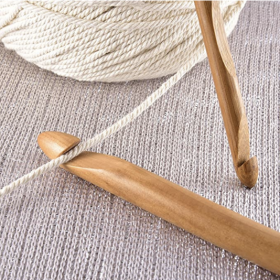 Not at all! You can use any kind of crochet hook – ergonomic, plastic, aluminum, wood or bamboo – whatever works best for you. And it may surprise you to know this: the crochet hook size lists in a crochet pattern is only a suggestion! Based on your personal tension, the type of yarn you are using, and blocking, you may need to use a different sized crochet hook than what the designer used when making the original sample.
Not at all! You can use any kind of crochet hook – ergonomic, plastic, aluminum, wood or bamboo – whatever works best for you. And it may surprise you to know this: the crochet hook size lists in a crochet pattern is only a suggestion! Based on your personal tension, the type of yarn you are using, and blocking, you may need to use a different sized crochet hook than what the designer used when making the original sample.
Let’s say you crocheted the gauge swatch and your swatch is smaller than the pattern’s suggested gauge: try again with a larger crochet hook.
Let’s say you crocheted the gauge swatch and your swatch is larger than the pattern’s suggested gauge: try again with a smaller crochet hook.
What is the different between free and paid crochet patterns?
Free and paid versions of patterns vary from designer to designer. Sometimes free versions of a pattern are a lighter version. For example, one size is given in the free pattern, but a size range is given in the paid version; or maybe the charts are only included in the paid version. Sometimes, free patterns are a marketing campaign to drive traffic to a website; or they are an enticement by a yarn company to encourage you to buy the yarn. Sometimes free patterns are given in exchange for sharing your information like email address and phone number for future marketing campaigns. And often, free pattern pages are full of advertisements.
Browse hundreds of free knit and crochet patterns here
All free and paid crochet patterns are created and written by designers.
Paid crochet patterns can be sold as physical printed products or they can be sold as PDF download files that can be emailed to you. Depending on where you purchase your paid crochet patterns, some websites offer you a download library in your account so you have access to your patterns. And they can include anywhere from 1 or 2 downloads or unlimited downloads. Check with the company to know what is included in the pattern. Ravelry and Etsy are two of the largest websites where you can purchase paid crochet patterns but there are thousands of options out there.
For example, when you sign up for an account on my website, every time you purchase a crochet pattern, knit pattern or ebook, you have 24/7 access to the files in your download library. And, I also offer unlimited downloads.
Browse hundreds of PDF knit and crochet patterns here
Paid and free are not monikers for the quality of a crochet pattern. Both paid and free patterns can be good or bad quality or somewhere in the middle.
What if I need help understanding something in my pattern?
Before you choose a pattern, you may want to consider what the pattern providers policy is for support?
- Does the designer or yarn company or website offer email support?
- Does the pattern have supplemental video tutorial?
- Is there a forum where you can ask others in the community if they can help?
- Is there a mistake in the pattern? Is there errata?
For Kristin Omdahl knit and crochet paterns, you can contact for pattern support here: PatternSupport@KristinOmdahl.com
And you can also ask others in the KO Community Forums for assistance here: KO Community Forums
What is a PDF pattern download?
PDF is an abbreviation that stands for Portable Document Format. It’s a universal file type created by Adobe that gives everyone a digital option to share documents – regardless of the software, hardware, or operating systems being used by anyone who views the document.
The PDF format is now an open standard, maintained by the International Organ zation for Standardization (ISO). PDF docs can contain links and buttons, form fields, audio, video, and business logic. They can be signed electronically and can easily be viewed on Windows or MacOS using the free Adobe Acrobat Reader software.
Download Adobe Acrobat Reader HERE
How do I read a PDF pattern?
You need to have a PDF reader app on your computer or devices. Adobe Acrobat is a free app that you can download onto any device to be able to read any PDF pattern.
Can I print a PDF pattern?
Yes. If you have a printer, print out your pattern. Staple the pages together to keep them in order. Place the pattern in a protective sleeve or even a 3 ring binder for ease in storing and organizing your patterns, too. Printing out your crochet pattern is a convenient option when you want to unplug from electronic devices. And you can also mark up a printout to help you keep your place in a larger crochet pattern.
Can I share my crochet patterns with my friends?
Yes! Please share the source of where to find crochet patterns with your friends. Share the website, or the specific link to the where you found the pattern. However, it is illegal to distribute patterns – free or purchased – with your friends. All crochet patterns and books are copyright protected for single user only.
 Kristin Omdahl is the best-selling author of dozens of knit and crochet books; designer of almost 1000 knit and crochet patterns; and producer of award-winning videos. You can join Kristin LIVE 5 days a week for The Kristin Omdahl Show on YouTube and browse through thousands of tutorial videos there, too. Kristin donates a portion of every sale to help survivors of domestic violence. Learn more about Kristin’s charity, Project Kristin Cares HERE.
Kristin Omdahl is the best-selling author of dozens of knit and crochet books; designer of almost 1000 knit and crochet patterns; and producer of award-winning videos. You can join Kristin LIVE 5 days a week for The Kristin Omdahl Show on YouTube and browse through thousands of tutorial videos there, too. Kristin donates a portion of every sale to help survivors of domestic violence. Learn more about Kristin’s charity, Project Kristin Cares HERE.
Shop all of Kristin Omdahl’s knitting and crochet patterns, books and courses here:
- Shop Kristin Omdahl Crochet Patterns
- Shop Kristin Omdahl Knitting Patterns
- Shop Kristin Omdahl Books
- Shop Kristin Omdahl Courses
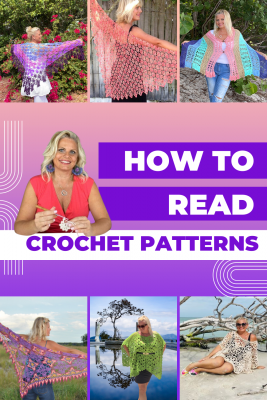 I would love to see your creations. Just as much fun as making these myself is the satisfaction I get from seeing my designs come to life and other knit and crochet fans wearing them too. There are now 2 ways you can share what you have done!
I would love to see your creations. Just as much fun as making these myself is the satisfaction I get from seeing my designs come to life and other knit and crochet fans wearing them too. There are now 2 ways you can share what you have done!
- I have recently added a wonderful new interactive section to the website which I invite you to take part in, it has been a smashing success and such fun so far. It is the new “Share Your Project” section. You, my creators, can upload images and descriptions of your creations to share with the ever growing community! To upload simply click here.
- If you want to continue the party, join the KO Community Forums on my website. It is 100% PRIVATE! You can start or join forum posts, and even direct message others, too. Join the KO Community forums HERE
Additionally, I host a livestreaming podcast, vlog or show weekday on my YouTube Channel called The Kristin Omdahl Show. You can join the audience and even ask me questions LIVE! I often do a show and tell, or quick demo and I always interact with the live audience. It is a lot of fun!
You can browse through over 1000 previously recorded episodes HERE: The Kristin Omdahl Show Playlist. Make sure to subscribe to my YouTube Channel to get reminders when the next episode airs LIVE.
You can also Refer-A-Friend and get rewarded, too! Learn more HERE
I look forward to seeing what you create!
xoxo,
Kristin


